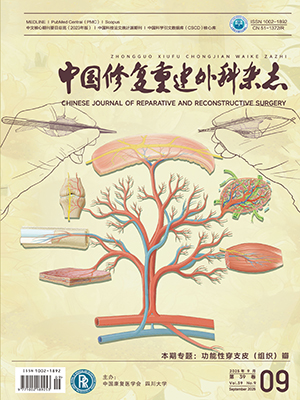Objective The bone marrow mesenchymal stem cells (BMSCs) have the capacity to differentiate into insul in-producing cells (IPCs) in vitro. However, low differentiation efficiency and poor maturity are the main obstacles. To investigate the feasibil ity of BMSCs differentiation into IPCs in diabetic pancreatic microenvironment of pigs. Methods BMSCs were isolated and purified from the bone marrow of a 4-week-old male pig. Fifteen female pigs (aged 8 to 10 weeks, weighing 8 to 10 kg) were randomly divided into 3 groups: normal control group (group A, n=5), diabetic control group (group B, n=5), and BMSCs transplanted group (group C, n=5). The pigs of groups B and C were treated by auris vein injections of styeptozocin and alloxan for 3 days to induce diabetes mell itus (DM) model, whose blood glucose level 2 days all greater than 17 mmol/L was successful DM model. A total of 1.1 mL of the 3rd passage BMSCs labeled with enhanced green fluorescent protein (EGFP), with cell density of 5 × 107/ mL, were injected into subcapsular pancreas of group C at multi ple points, normal saline at the same dosage into those of groups A and B. After 30 days of monitoring blood glucose, the histological analysis of islet number and size were done; the immunofluorescence staining was used to detect the protein expression of insul in in the new-formed islets. The EGFP+ cells were collected from the sections using laser-capture microdissection; RT-PCR was used to detect insulin mRNA and pancreatic and duodenal homeobox factor 1 (PDX1) mRNA expressions from EGFP+ cells, and the insul in and sexdetermining region of the Y chromosome (SRY) genes were detected by fluorescence in situ hybridization (FISH). Results The blood glucose level decreased significantly in group C when compared with that in group B from 18 days and gradually decreased with time (P lt; 0.05). The histological observation showed that the number of islets was increased significantly in group C when compared with that in group B (10.9 ± 2.2 vs. 4.6 ± 1.4, P lt; 0.05), and there was no significant difference when compared with that in group A (10.9 ± 2.2 vs.12.6 ± 2.6, P gt; 0.05). The size of new-formed islets in group C was significantly smaller than that in group A [(47.2 ± 19.6) μm vs. (119.6 ± 27.7) μm, P lt; 0.05]. The immunofluorescence staining showed that new-formed islets of group C expressed insulin protein. RT-PCR showed that the microdissected EGFP+ cells of group C expressed insulin mRNA and PDX-1 mRNA. FISH showed that the new-formed islet cells of group C contained SRY gene in Y chromosome and insulin double positive cells. Conclusion BMSCs can differentiate into IPCs in diabetic pancreatic microenvironment of pigs.
Citation: XIE Hongbin,CHANG Caihong,JIANG Jinxing,LI Qing,QI Hui,DENG Chunyan,LI Furong. FEASIBILITY OF BONE MARROW MESENCHYMAL STEM CELLS DIFFERENTIATION IN DIABETIC PANCREATIC MICROENVIRONMENT. Chinese Journal of Reparative and Reconstructive Surgery, 2011, 25(5): 597-601. doi: Copy
Copyright © the editorial department of Chinese Journal of Reparative and Reconstructive Surgery of West China Medical Publisher. All rights reserved




